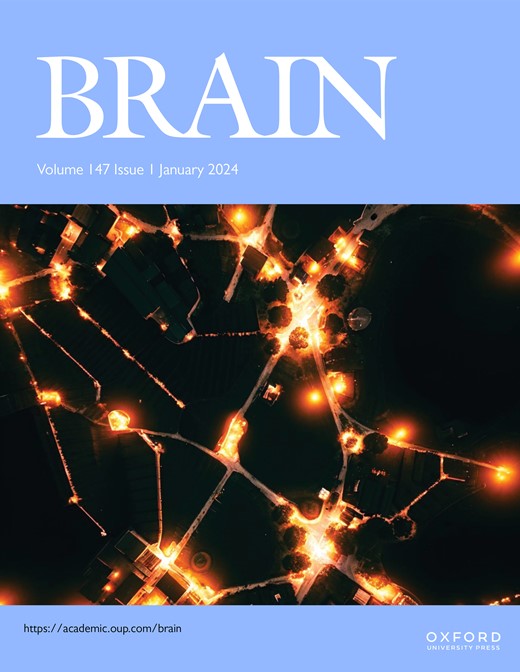Default mode network tau predicts future clinical decline in atypical early Alzheimer’s disease
IF 10.6
1区 医学
Q1 CLINICAL NEUROLOGY
引用次数: 0
Abstract
Identifying individuals with early-stage Alzheimer’s disease (AD) at greater risk of steeper clinical decline would enable better-informed medical, support, and life planning decisions. Despite accumulating evidence on the clinical prognostic value of tau positron emission tomography (PET) in typical late-onset amnestic AD, its utility in predicting clinical decline in individuals with atypical forms of AD remains unclear. Across heterogeneous clinical phenotypes, patients with atypical AD consistently exhibit abnormal tau accumulation in the posterior nodes of the default mode network of the cerebral cortex. This evidence suggests that tau burden in this functional network could be a common imaging biomarker for prognostication across the syndromic spectrum of AD. Here, we examined the relationship between baseline tau PET signal and the rate of subsequent clinical decline in a sample of 48 A+/T+/N+ patients with mild cognitive impairment or mild dementia due to AD with atypical clinical phenotypes: Posterior Cortical Atrophy (n = 16), logopenic variant Primary Progressive Aphasia (n = 15), and amnestic syndrome with multi-domain impairment and young age of onset < 65 years (n = 17). All patients underwent magnetic resonance imaging (MRI), tau PET, and amyloid PET scans at baseline. Each patient’s longitudinal clinical decline was assessed by calculating the annualized change in the Clinical Dementia Rating Sum-of-Boxes (CDR-SB) scores from baseline to follow-up (mean time interval = 14.55 ± 3.97 months). Atypical early AD patients showed an increase in CDR-SB by 1.18 ± 1.25 points per year: t(47) = 6.56, p < .001, Cohen’s d = 0.95. Across clinical phenotypes, baseline tau in the default mode network was the strongest predictor of clinical decline (R2 = .30), outperforming a simpler model with baseline clinical impairment and demographic variables (R2 = .10), tau in other functional networks (R2 = .11-.26), and the magnitude of cortical atrophy (R2 = .20) and amyloid burden (R2 = .09) in the default mode network. Overall, these findings point to the contribution of default mode network tau to predicting the magnitude of clinical decline in atypical early AD patients one year later. This simple measure could aid the development of a personalized prognostic, monitoring, and treatment plan, which would help clinicians not only predict the natural evolution of the disease but also estimate the effect of disease-modifying therapies on slowing subsequent clinical decline given the patient’s tau burden while still early in the disease course.默认模式网络 tau 预测非典型早期阿尔茨海默病未来的临床衰退
早期阿尔茨海默病(AD)患者的临床衰退风险较高,如果能识别出这些患者,就能做出更明智的医疗、支持和生活规划决策。尽管有越来越多的证据表明,tau 正电子发射断层扫描(PET)对典型的晚发性失忆性阿尔茨海默病具有临床预后价值,但它在预测非典型阿尔茨海默病患者临床衰退方面的作用仍不明确。在各种不同的临床表型中,非典型AD患者在大脑皮层默认模式网络的后部节点始终表现出异常的tau堆积。这些证据表明,这一功能网络中的 tau 负荷可能是一种常见的影像生物标志物,可用于 AD 综合征谱系的预后判断。在这里,我们研究了48例A+/T+/N+轻度认知障碍或轻度痴呆患者的基线tau PET信号与随后临床衰退速度之间的关系:后皮质萎缩症(16 例)、对数开放变异型原发性进行性失语症(15 例)和伴有多领域损害和年轻发病年龄 < 65 岁的失忆综合征(17 例)。所有患者都在基线时接受了磁共振成像(MRI)、tau PET和淀粉样蛋白PET扫描。通过计算从基线到随访期间(平均时间间隔 = 14.55 ± 3.97 个月)临床痴呆评分总和(CDR-SB)分数的年化变化,评估每位患者的纵向临床衰退情况。非典型早期AD患者的CDR-SB每年增加1.18 ± 1.25分:t(47) = 6.56, p < .001, Cohen's d = 0.95。在所有临床表型中,默认模式网络中的基线tau是临床衰退的最强预测因子(R2 = .30),优于包含基线临床损害和人口统计学变量(R2 = .10)、其他功能网络中的tau(R2 = .11-.26)以及默认模式网络中皮质萎缩(R2 = .20)和淀粉样蛋白负荷(R2 = .09)的简单模型。总之,这些发现表明默认模式网络tau有助于预测非典型早期AD患者一年后临床衰退的程度。这种简单的测量方法有助于制定个性化的预后、监测和治疗计划,不仅能帮助临床医生预测疾病的自然演变,还能根据患者在病程早期的 tau 负担,估计疾病调整疗法对减缓后续临床衰退的效果。
本文章由计算机程序翻译,如有差异,请以英文原文为准。
求助全文
约1分钟内获得全文
求助全文
来源期刊

Brain
医学-临床神经学
CiteScore
20.30
自引率
4.10%
发文量
458
审稿时长
3-6 weeks
期刊介绍:
Brain, a journal focused on clinical neurology and translational neuroscience, has been publishing landmark papers since 1878. The journal aims to expand its scope by including studies that shed light on disease mechanisms and conducting innovative clinical trials for brain disorders. With a wide range of topics covered, the Editorial Board represents the international readership and diverse coverage of the journal. Accepted articles are promptly posted online, typically within a few weeks of acceptance. As of 2022, Brain holds an impressive impact factor of 14.5, according to the Journal Citation Reports.
 求助内容:
求助内容: 应助结果提醒方式:
应助结果提醒方式:


